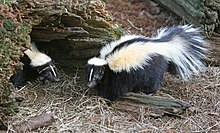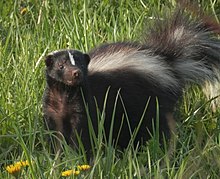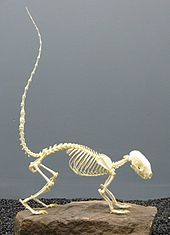Skunk
| Skunks | |
|---|---|

| |
| Striped skunks | |
| Scientific classification | |
| Kingdom: | Animalia |
| Phylum: | Chordata |
| Class: | Mammalia |
| Order: | Carnivora |
| Superfamily: | Musteloidea |
| Family: | Mephitidae |
| Groups included | |
|
Conepatus | |
Skunks are New World mammals in the family Mephitidae. They are known for their ability to spray a liquid with a strong, unpleasant scent from their anal glands. Different species of skunk vary in appearance from black-and-white to brown, cream or ginger colored, but all have warning coloration.
While related to polecats and other members of the weasel family, skunks have as their closest relatives the Old World stink badgers.[1]
Cultural aspects[]
Etymology[]
The word "skunk" is dated from the 1630s, adapted from a southern New England Algonquian language (probably Abenaki) seganku, from Proto-Algonquian */šeka:kwa/, from */šek-/ 'to urinate' + */-a:kw/ 'fox'.[2]
Slang[]
"Skunk" has historic use as an insult, attested from 1841.[3] The term has also been used to describe the act of overwhelmingly defeating an opponent in a game or competition, particularly by preventing the said opponent from scoring at all.
"Skunk" is also used to refer to certain strong-smelling strains of marijuana whose smell has been compared to that of a skunk's spray.
In Southern United States dialect, the term polecat is sometimes used as a colloquial nickname for a skunk,[4] even though polecats are only distantly related to skunks.
History of European awareness[]
In 1634, a skunk was described in The Jesuit Relations:
The other is a low animal, about the size of a little dog or cat. I mention it here, not on account of its excellence, but to make of it a symbol of sin. I have seen three or four of them. It has black fur, quite beautiful and shining; and has upon its back two perfectly white stripes, which join near the neck and tail, making an oval that adds greatly to their grace. The tail is bushy and well furnished with hair, like the tail of a Fox; it carries it curled back like that of a Squirrel. It is more white than black; and, at the first glance, you would say, especially when it walks, that it ought to be called Jupiter's little dog. But it is so stinking and casts so foul an odor, that it is unworthy of being called the dog of Pluto. No sewer ever smelled so bad. I would not have believed it if I had not smelled it myself. Your heart almost fails you when you approach the animal; two have been killed in our court, and several days afterward there was such a dreadful odor throughout our house that we could not endure it. I believe the sin smelled by Saint Catherine de Sienne must have had the same vile odor.[5]
Biology[]
Physical description[]
Skunk species vary in size from about 15.6 to 37 in (40 to 94 cm) long and in weight from about 1.1 lb (0.50 kg) (spotted skunks) to 18 lb (8.2 kg) (hog-nosed skunks). They have moderately elongated bodies with relatively short, well-muscled legs and long front claws for digging. They have five toes on each foot.

Although the most common fur color is black and white, some skunks are brown or grey and a few are cream-colored. All skunks are striped, even from birth. They may have a single thick stripe across the back and tail, two thinner stripes, or a series of white spots and broken stripes (in the case of the spotted skunk).
Diet[]
Skunks are omnivorous, eating both plant and animal material and changing their diets as the seasons change. They eat insects, larvae, earthworms, grubs, rodents, lizards, salamanders, frogs, snakes, birds, moles, and eggs. They also commonly eat berries, roots, leaves, grasses, fungi and nuts.
In settled areas, skunks also seek garbage left by humans. Less often, skunks may be found acting as scavengers, eating bird and rodent carcasses left by cats or other animals. Pet owners, particularly those of cats, may experience a skunk finding its way into a garage or basement where pet food is kept. Skunks commonly dig holes in lawns in search of grubs and worms.
Skunks are one of the primary predators of the honeybee, relying on their thick fur to protect them from stings. The skunk scratches at the front of the beehive and eats the guard bees that come out to investigate. Mother skunks are known to teach this behavior to their young. Also, in California, skunks dig up yellowjacket (small hornet) nests in summer, after the compacted soil under oak trees dries out and cracks open, which allows the yellowjackets to build their nests underground.[citation needed]
Behavior[]

Skunks are crepuscular and solitary animals when not breeding, though in the colder parts of their range, they may gather in communal dens for warmth. During the day they shelter in burrows, which they can dig with their powerful front claws. Males and females occupy overlapping home ranges through the greater part of the year, typically 2 to 4 km2 (0.77 to 1.54 sq mi) for females and up to 20 km2 (7.7 sq mi) for males.
Skunks are not true hibernators in the winter, but do den up for extended periods of time. However, they remain generally inactive and feed rarely, going through a dormant stage. Over winter, multiple females (as many as 12) huddles together; males often den alone. Often, the same winter den is repeatedly used.
Although they have excellent senses of smell and hearing, they have poor vision, being unable to see objects more than about 3 m (10 ft) away, making them vulnerable to death by road traffic. They are short-lived; their lifespan in the wild can reach seven years, with most living only up to a year.[6][7] In captivity, they may live for up to 10 years.[6][7]
Reproduction[]
Skunks mate in early spring and are polygynous (that is, successful males are uninhibited from mating with additional females.)
Before giving birth (usually in May), the female excavates a den to house her litter of four to seven kits.
Skunks are placental, with a gestation period of about 66 days.[8]
When born, skunk kits are blind, deaf, but already covered by a soft layer of fur. About three weeks after birth, they first open their eyes; the kits are weaned about two months after birth. They generally stay with their mother until they are ready to mate, roughly at one year of age.
The mother is protective of her kits, spraying at any sign of danger. The male plays no part in raising the young.[9]
Spray[]

Skunks are notorious for their anal scent glands, which they can use as a defensive weapon. They are similar to, though much more developed than, the glands found in species of the family Mustelidae. Skunks have two glands, one on each side of the anus. These glands produce the skunk's spray, which is a mixture of sulfur-containing chemicals such as thiols (traditionally called mercaptans), which have an offensive odor. A skunk's spray is powerful enough to ward off bears and other potential attackers.[10] Muscles located next to the scent glands allow them to spray with a high degree of accuracy, as far as 3 m (10 ft). The spray can also cause irritation and even temporary blindness, and is sufficiently powerful to be detected by a human nose up to 5.6 km (3.5 miles) downwind.[citation needed] Their chemical defense is effective, as illustrated by this extract from Charles Darwin's Voyage of the Beagle:
We saw also a couple of Zorrillos, or skunks—odious animals, which are far from uncommon. In general appearance, the Zorrillo resembles a polecat, but it is rather larger and much thicker in proportion. Conscious of its power, it roams by day about the open plain and fears neither dog nor man. If a dog is urged to the attack, its courage is instantly checked by a few drops of the fetid oil, which brings on violent sickness and running at the nose. Whatever is once polluted by it, is forever useless. Azara says the smell can be perceived at a league distance; more than once, when entering the harbour of Monte Video, the wind being offshore, we have perceived the odour onboard the Beagle. Certain it is, that every animal most willingly makes room for the Zorrillo.[11]
Skunks carry just enough of the chemical for five or six successive sprays – about 15 cm3 – and require up to ten days to produce another supply.[12] Their bold black and white coloration makes their appearance memorable. It is to a skunk's advantage to warn possible predators off without expending scent: black and white aposematic warning coloration aside, threatened skunks will go through an elaborate routine of hisses, foot-stamping, and tail-high deimatic or threat postures before resorting to spraying. Skunks usually do not spray other skunks, except among males in the mating season. If they fight over den space in autumn, they do so with teeth and claws.[citation needed]
Most predators of the Americas, such as wolves, foxes, and badgers, seldom attack skunks, presumably out of fear of being sprayed. The exceptions are reckless predators whose attacks fail once they are sprayed, dogs, and the great horned owl,[13] which is the skunk's only regular predator.[14] In one case, the remains of 57 striped skunks were found in a single great horned owl nest.[15]
Skunks are common in suburban areas. Frequent encounters with dogs and other domestic animals, and the release of the odor when a skunk is run over, have led to many myths about the removal of skunk odor; an especially popular myth is that tomato juice will neutralize the odor of a skunk. These household remedies are ineffective.[16] The Humane Society of the United States recommends treating dogs using a mixture of dilute hydrogen peroxide (3%), baking soda, and dishwashing liquid.[17]
Skunk spray is composed mainly of three low-molecular-weight thiol compounds, (E)-2-butene-1-thiol, 3-methyl-1-butanethiol, and 2-quinolinemethanethiol, as well as acetate thioesters of these.[18][19][20][21][22] These compounds are detectable by the human nose at concentrations of only 11.3 parts per billion.[23][24]

Relations with humans[]
Bites[]
It is rare for a healthy skunk to bite a human, though a tame skunk whose scent glands have been removed (usually on behalf of those who will keep it as a pet) may defend itself by biting. There are, however, few recorded incidents of skunks biting humans. Skunk bites in humans can result in infection with the rabies virus (reflecting the virus's "evolutionary strategy" of, in effect, promoting its spread via the so-called mad-dog syndrome). The Centers for Disease Control (CDC) recorded 1,494 cases of rabies in skunks in the United States for the year 2006—about 21.5% of reported cases in all species.[25][26] Skunks in fact are less prominent than raccoons as vectors of rabies. (However, this varies regionally in the United States, with raccoons dominating along the Atlantic coast and the eastern Gulf of Mexico, while skunks instead predominate throughout the Midwest, including the western Gulf, and in California.)
As pets[]

Mephitis mephitis, the striped skunk, is the most social skunk and the one most commonly kept as a pet. In the US, skunks can legally be kept as pets in 17 states.[27] When a skunk is kept as a pet, its scent glands are often surgically removed.[27]

In the UK, skunks can be kept as pets,[28] but the Animal Welfare Act 2006 made it illegal to remove their scent glands.[29]
Classification[]
In alphabetical order, the living species of skunks are:[30]

- Family Mephitidae
- Genus: Conepatus
- Conepatus chinga – Molina's hog-nosed skunk
- Conepatus humboldtii – Humboldt's hog-nosed skunk
- Conepatus leuconotus – American hog-nosed skunk
- Conepatus semistriatus – striped hog-nosed skunk
- Genus: Mephitis
- Mephitis macroura – hooded skunk
- Mephitis mephitis – striped skunk
- Genus: Spilogale
- Spilogale angustifrons – southern spotted skunk
- Spilogale gracilis – western spotted skunk
- Spilogale putorius – eastern spotted skunk
- Spilogale pygmaea – pygmy spotted skunk
- Genus: Conepatus
See also[]
- List of fictional skunks
- Skunk oil
References[]
- ^ "Old World skunk". Retrieverman.net. 2 November 2015. Retrieved 13 December 2018.
- ^ "skunk (n.)". Online Etymology Dictionary. Retrieved 18 March 2021.
- ^ Harper, Douglas. "skunk". Online Etymology Dictionary.
- ^ "Skunk Fact Sheet" (PDF). The Georgia Department of Natural Resources Wildlife Resources Division.
- ^ Thwaites, Reuben Gold, ed. (1633–1634). The Jesuit Relations and Allied Documents. Travels and Explorations of the Jesuit Missionaries in New France 1610—1791. VI. Quebec. Archived from the original on 15 December 2001.
- ^ Jump up to: a b ADW: Mephitis mephitis: INFORMATION. Animaldiversity.ummz.umich.edu. Retrieved on 5 April 2012.
- ^ Jump up to: a b Virtual Nature Trail. Striped Skunk. The Pennsylvania State University (2002).
- ^ "Skunks Management Guidelines". Ipm.ucdavis.edu.
- ^ "Eastern Spotted Skunk". Missouri Department of Conservation. Retrieved 23 February 2019.
- ^ "Ask a Bear: Skunk Spray as Deterrent?". 4 May 2011.
- ^ Darwin, Charles (1839). Voyage of the Beagle. London, England: Penguin. ISBN 0-14-043268-X. Retrieved 27 June 2006.
- ^ Biology and Control of Skunks. Agriculture and Rural Development. Government of Alberta, Canada. 1 June 2002
- ^ "Oregon Zoo Animals: Great Horned Owl". Oregonzoo.org. Archived from the original on 19 March 2012. Retrieved 9 February 2012.
- ^ "Great Horned Owl". The Cornell Lab of Ornithology. Archived from the original on 5 July 2017. Retrieved 21 March 2013.
- ^ Hunter, Luke (2011). Carnivores of the World. Princeton, NJ: Princeton University Press. ISBN 978-0-691-15228-8.[page needed]
- ^ Is it true that tomato sauce will get rid of the smell of a skunk?. Scienceline. Retrieved on 5 April 2012.
- ^ "De-skunking your dog". The Humane Society of the United States.
- ^ Andersen K. K.; Bernstein D. T. (1978). "Some Chemical Constituents of the Scent of the Striped Skunk (Mephitis mephitis)". Journal of Chemical Ecology. 1 (4): 493–499. doi:10.1007/BF00988589. S2CID 9451251.
- ^ Andersen K. K.; Bernstein D. T. (1978). "1-Butanethiol and the Striped Skunk". Journal of Chemical Education. 55 (3): 159–160. Bibcode:1978JChEd..55..159A. doi:10.1021/ed055p159.
- ^ Andersen K. K.; Bernstein D. T.; Caret R. L.; Romanczyk L. J. Jr. (1982). "Chemical Constituents of the Defensive Secretion of the Striped Skunk (Mephitis mephitis)". Tetrahedron. 38 (13): 1965–1970. doi:10.1016/0040-4020(82)80046-X.
- ^ Wood W. F.; Sollers B. G.; Dragoo G. A.; Dragoo J. W. (2002). "Volatile Components in Defensive Spray of the Hooded Skunk, Mephitis macroura". Journal of Chemical Ecology. 28 (9): 1865–70. doi:10.1023/A:1020573404341. PMID 12449512. S2CID 19217201.
- ^ Wood, William F. "Chemistry of Skunk Spray". Dept. of Chemistry, Humboldt State University. Retrieved 27 July 2010.
- ^ Wood, William F. (1999). "The History of Skunk Defensive Secretion Research" (PDF). Chem. Educator. 4 (2): 44–50. doi:10.1007/s00897990286a. S2CID 94181805. Archived from the original (PDF) on 2 September 2003.
- ^ Aldrich, T.B. (1896). "A chemical study of the secretion of the anal glands of mephitis mephitica (common skunk), with remarks on the physiological properties of this secretion". J. Exp. Med. 1 (2): 323–340. doi:10.1084/jem.1.2.323. PMC 2117909. PMID 19866801.
- ^ Blanton J.D.; Hanlon C.A.; Rupprecht C.E. (2007). "Rabies surveillance in the United States during 2006". Journal of the American Veterinary Medical Association. 231 (4): 540–56. doi:10.2460/javma.231.4.540. PMID 17696853.; Updated in Dyer JL, Yager P, Orciari L, Greenberg L, Wallace R, Hanlon CA, Blanton JD (2014). "Rabies surveillance in the United States during 2013". J Am Vet Med Assoc. 245 (10): 1111–23. doi:10.2460/javma.245.10.1111. PMC 5120391. PMID 25356711.
- ^ "Rabies Surveillance US 2006" (PDF). U.S. Centers for Disease Control and Prevention.
- ^ Jump up to: a b "Is That Skunk? | Do Skunks Make Good Pets?". PBS. 20 November 2008.
- ^ "A stink in the tale: Why Britain is swooning over the pet with a pong". The Independent. 23 April 2011.
- ^ "Animal Welfare Act 2006" (PDF). Retrieved 5 December 2009.
- ^ Wilson, D.E.; Reeder, D.M., eds. (2005). Mammal Species of the World: A Taxonomic and Geographic Reference (3rd ed.). Johns Hopkins University Press. ISBN 978-0-8018-8221-0. OCLC 62265494.
External links[]
| Wikisource has the text of the 1911 Encyclopædia Britannica article Skunk. |
- Skunk at Curlie
- Skunks and the management of skunk damage Archived 13 November 2016 at the Wayback Machine
- Skunks
- Mephitidae
- Mammals of Canada
- Mammals of the United States
- Aposematic animals
- Mammal common names